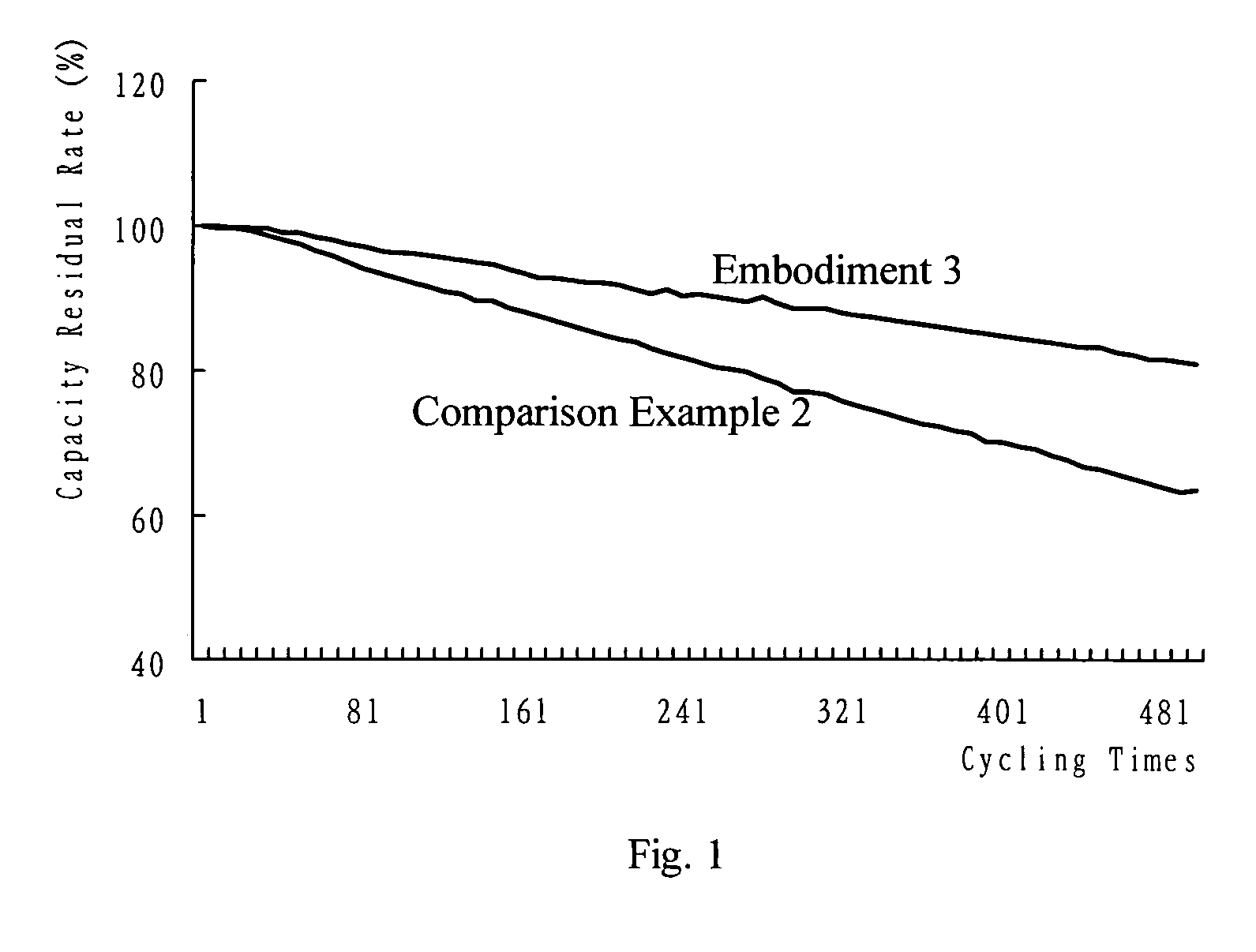Materials for negative electrodes of lithium ion batteries
a lithium ion battery and material technology, applied in the direction of conductors, natural mineral layered products, cell components, etc., can solve the problems of reducing the initial charge-discharge electrical efficiency, affecting the performance of a battery, and loosening of materials in the electrode, etc., to achieve excellent initial charge-discharge efficiency, long cycling life, and large battery capacity
- Summary
- Abstract
- Description
- Claims
- Application Information
AI Technical Summary
Benefits of technology
Problems solved by technology
Method used
Image
Examples
embodiment 1
Sample #10 of Embodiment 1
[0078]To obtain Sample #10, 20 units of aluminum lithium alloy composites are added to the material for the negative electrode. Everything else remains the same as Sample No. 1.
Testing of the Electrochemical Properties of the Samples and Comparison Examples
[0079]Batteries from the Comparison Example 1 and the samples of Embodiment 1 are charged at a constant voltage. The current in these batteries is limited to 0.05C (30 mA). The final voltage is 4.2V. After charging, the batteries are discharged at a constant current. The discharging current is 0.05C (30 mA). The cut-off voltage is 3V. The results of the testing are shown in Table 1.
[0080]
TABLE 1Active MaterialDischargefor NegativeCapacityElectrodes:AlloyInitial(mAh / g)Granules coatedCharging-TheThewith CarbonDischargingfirstsecondNo.MaterialRate (%)cyclecycleComparison100:0 85.3605.2610.6Example 1EmbodimentNo. 1100:2 87.3611.1612.51No. 2100:4 89.2618.7619.4No. 3100:6 90.3627.2627.5No. 4100:8 91.6631.3631.2...
embodiment 2
Sample #18 of Embodiment 2
[0089]To obtain Sample #18, 8 units of copper lithium alloy composites are added to the material for the negative electrode. Each copper lithium alloy composite is one or more copper lithium alloy granules coated with carbon material where the average granule diameter of the copper lithium alloy granule is 19 μm. The copper Cu is 70 wt % of the copper lithium alloy. Everything else remains the same as Sample No. 11.
Testing of the Electrochemical Properties of the Samples and Comparison Examples
[0090]The testing protocol for the electrochemical properties of these samples in Embodiment 2 is the same as the samples in Embodiment 1. The results are shown in Table 2.
[0091]
TABLE 2Comparison between Embodiment 2 and Comparison Example 1Li-M alloysActive MaterialsDischargeM ContentAlloyfor NegativeInitialCapacity (mAh / g)(ofCoreElectrodes: AlloysCharge-TheGranulesDiameterCompositesDischargeFirstThe SecondNo.Mwt %)(μm)(wt %)Rate (%)CycleCycleComparison———100:085.360...
embodiment 3
[0094]100 units of graphite produced in China is used as the active material for the negative electrode. In addition, 8 units of aluminum lithium alloy composites are added. Each aluminum lithium alloy composite is one or more aluminum lithium alloy granules coated with carbon material where the average granule diameter of the aluminum lithium alloy granule is 16 μm. Everything else remains the same as the Comparison Example 1.
Testing of Cycling Properties
[0095]The cycling properties of the batteries using the materials describe in Embodiment 3 and Comparison Example 2 are negative electrodes are tested as follows. Each battery is charged at constant voltage. The current is limited to 1 C(600 mA). The final voltage is 4.2V. The discharge is at constant current. The discharging current is 1C(600 mA). The cut-off discharging voltage of is 3V. Each battery is cycled for 500 times. The capacity residual rate percent is the percent ratio of discharge capacity to the initial discharge cap...
PUM
| Property | Measurement | Unit |
|---|---|---|
| diameter | aaaaa | aaaaa |
| diameter | aaaaa | aaaaa |
| granule diameter | aaaaa | aaaaa |
Abstract
Description
Claims
Application Information
 Login to View More
Login to View More - R&D
- Intellectual Property
- Life Sciences
- Materials
- Tech Scout
- Unparalleled Data Quality
- Higher Quality Content
- 60% Fewer Hallucinations
Browse by: Latest US Patents, China's latest patents, Technical Efficacy Thesaurus, Application Domain, Technology Topic, Popular Technical Reports.
© 2025 PatSnap. All rights reserved.Legal|Privacy policy|Modern Slavery Act Transparency Statement|Sitemap|About US| Contact US: help@patsnap.com

